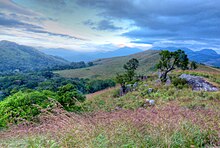A thorn forest is a dense scrubland with vegetation characteristic of dry subtropical and warm temperate areas with a seasonal rainfall averaging 250 to 500 mm (9.8 to 19.7 in).

Regions
editAfrica
editIs present in the southwest of Africa with smaller areas in other places of Africa.
- Thornveld often referred to as "acacia thornveld"
- Madagascar spiny forests
North America
editThorn forests cover a large part of southwestern North America.
- Pinyon–juniper woodland in Utah and the Canyonlands region.[1]
South America
editIn South America, the thorn forest is called Caatinga, and consists primarily of small, thorny trees that shed their leaves seasonally. Trees typically do not exceed 10 metres (33 ft) in height, usually averaging between 7 and 8 metres (23 and 26 ft) tall.
Caatinga is considered a xeric shrubland and thorn forest,[2] but contains the ecoregion Caatinga Enclaves moist forests that is considered Tropical and subtropical dry broadleaf forests.
Asia
edit- Deccan thorn scrub forests in India and Sri Lanka. Deccan is included in the Indomalayan biorealm, on the deserts and xeric shrublands biome.[3]
- Northwestern thorn scrub forests in India and Pakistan
Australia
editTransition
editThorn forests blend into savanna woodlands as the rainfall increases and into deserts as the climate becomes drier.[5]
See also
editReferences
edit- ^ Damian Fagan, Canyon Country Wildflowers, p. 3
- ^ Lleras, Eduardo. "Caatinga of North-Eastern Brazil". Centres of Plant Diversity. Vol. 3: The Americas. Smithsonian Institution. Archived from the original on 3 March 2016.
- ^ "Deccan thorn scrub forests". Terrestrial Ecoregions. World Wildlife Fund.
- ^ Maslin, Bruce; Reid, Jordan (2009). "Understanding Mulga" (PDF). Science Division, Department of Environment and Conservation, Western Australia. Retrieved 3 September 2019.
- ^ Shreve F. (1934). "Vegetation of the Northwestern Coast of Mexico". Bulletin of the Torrey Botanical Club. 61 (7): 373–380. JSTOR 2481022.